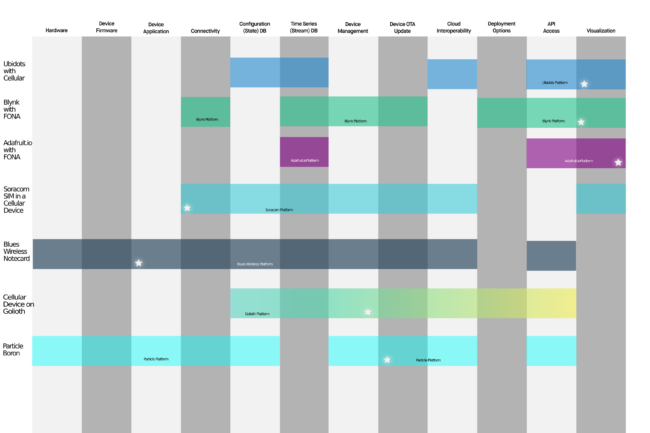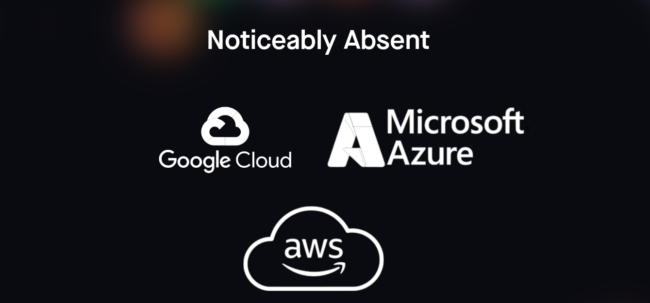When I started at Golioth, I wanted to understand the service offerings from different companies in the space. What resulted, was a chart (below), slideshow (below), and a presentation I have now given a couple different times (video, above). All of these things showcase how I started to investigate and understand the inter-operating pieces of any modern Internet of Things (IoT) system.
Only 12 Layers?
Let’s start with the obvious: I could have chosen just about any number of layers to explain IoT systems.
I chose to highlight the pieces of IoT systems as someone working on building Reference Designs, which have a Device component and a Cloud component. I framed many of these capabilities from the perspective of my time at Golioth and the aspects of the system that I found to be crucial to a deployment. I wanted to understand the competitive landscape as a starting point (finding other companies providing IoT platforms) and expanded from there.
I stopped at 12, because that is roughly the amount I thought I could describe without audience members falling asleep. 12 layers also captures a good amount of functionality. However, it misses many other pieces of IoT implementation and very easily could have been the 100 layers of IoT.
The Chart
The true beginning of this talk was a diagram I created. It shows how I understood offerings from different IoT providers, with varying levels of “vertical integration” (how much of the solution they provide to their users). Some providers go all the way from the hardware up to the Cloud. Some provide key infrastructure pieces (like Golioth) and point you at external providers in order to give you more flexibility. Some are hyper specialized in one area.
The key idea was to point out that these providers exist and that there are different reasons to choose one over another. That is to say: each has a valid business proposition and fits a customer profile. One provider might serve an operations group that is looking to add connectivity to an existing business and simply spit data out onto the internet—many businesses want that. Other times, a technology group inside a larger product development company might be looking to supplement their product design capabilities and not do everything in-house. It’s important to understand the landscape as a design engineer evaluating what they should buy and what they should DIY. Each layer in the presentation has the pro’s and con’s of “Buy vs DIY”.
Beyond IoT Platform Providers
Unstated and unshown on the chart is the “DIY” of IoT subsystems. As mentioned in the video and slides, it’s possible that companies want to develop everything from the ground up and maintain all of their own IP. The downside is the high cost in terms of people and time, and often the “full DIY” method of developing is relegated to the largest companies looking to develop an IoT product.

Others are utilizing building blocks from hyper-scalers like AWS and Azure. Sometimes this takes the form of using hyper scaler IoT platforms (AWS IoT, Azure IoT), and other times, they use even more basic computing elements in the cloud (EC2s, S3 buckets, Lambdas). In all these cases, there is a significant amount of “Cloud Software” that is written and maintained by the company looking to develop an IoT product.
How do the 12 Layers of IoT impact you?
These resources exist to help engineers and business people new to the IoT industry to understand how to create successful IoT deployments. Most importantly, this talk sought to remedy the problem of “you don’t know what you don’t know” (reference). If you don’t know about potential pitfalls in deploying an IoT solution and what you might need 2 or 3 years down the line, you won’t be able to take steps up front to prevent those problems.
A tangible example is in “layer 10”, which is listed as “deployment flexibility”. If you want to hire an IoT platform to get your deployment off the ground, but later will want to run your own cloud infrastructure, you need to choose different options when creating your system. Platforms like Golioth allow you to run your own cloud infrastructure as part of our Enterprise plan. Companies that don’t choose this path at the beginning of their deployment find themselves re-architecting their entire solution (all the way down to the hardware) at a later time in order to implement a bespoke cloud solution that fits their needs.
The Presentation
Below is a refined version of the talk that I gave at All Things Open in Raleigh NC in November 2022. Unfortunately that version of the talk wasn’t recorded, but the slides below are the most up-to-date version I have.
Did I miss a layer?
I am continually refining my concept of what comprises IoT deployments and the required pieces. It’s possible I missed out on something important. Maybe there are critical pieces of infrastructure that you think I glossed over. We’d love to hear your thoughts on our forum or on social media (Twitter, LinkedIn, Facebook).


No comments yet! Start the discussion at forum.golioth.io